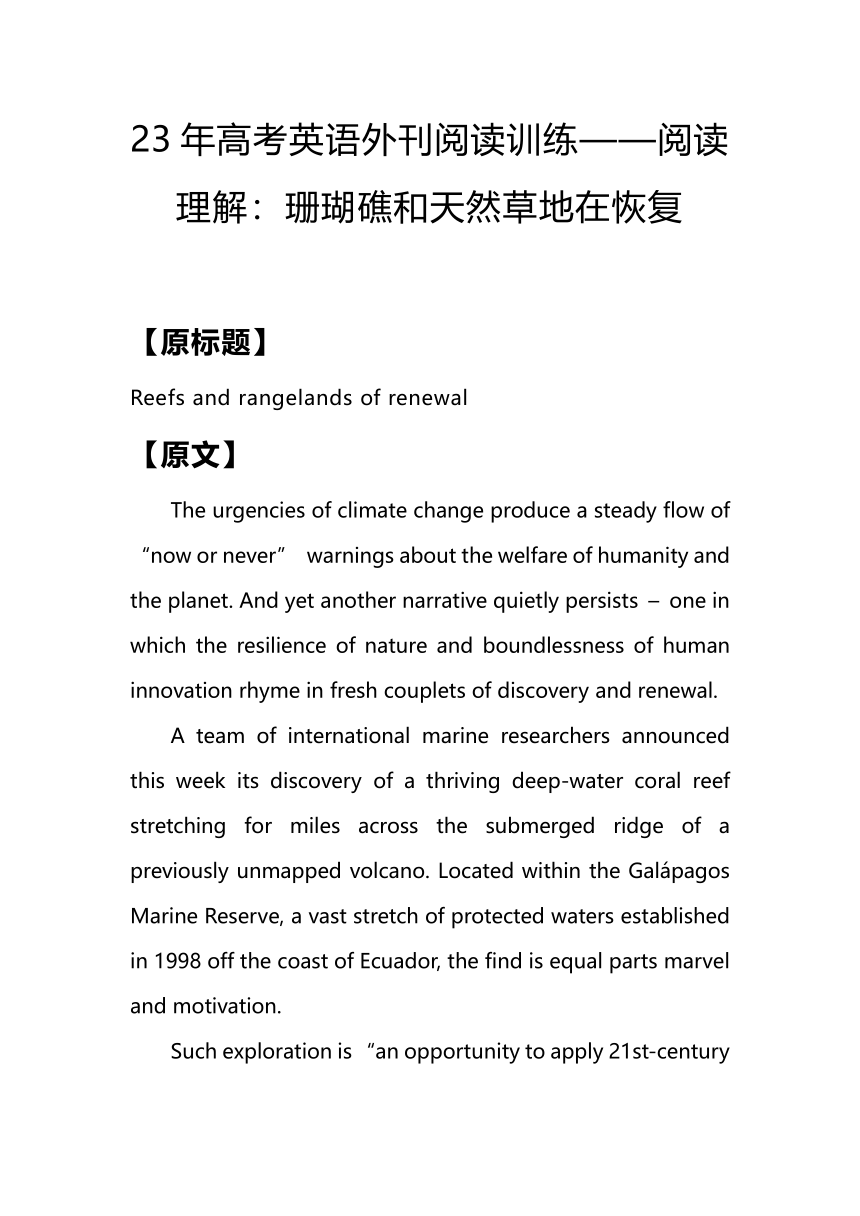
23年高考英语外刊阅读训练———阅读理解:珊瑚礁和天然草地在恢复 【原标题】 Reefs and rangelands of renewal 【原文】 The urgencies of climate change produce a steady flow of “now or never” warnings about the welfare of humanity and the planet. And yet another narrative quietly persists – one in which the resilience of nature and boundlessness of human innovation rhyme in fresh couplets of discovery and renewal. A team of international marine researchers announced this week its discovery of a thriving deep-water coral reef stretching for miles across the submerged ridge of a previously unmapped volcano. Located within the Galápagos Marine Reserve, a vast stretch of protected waters established in 1998 off the coast of Ecuador, the find is equal parts marvel and motivation. Such exploration is “an opportunity to apply 21st-century deep-submergence and seafloor mapping technologies and innovative deep-sea imaging techniques to reveal the beauty and complexity of the volcanic and biological processes,” said Daniel Fornari, a marine geologist at the Woods Hole Oceanographic Institution who co-led the expedition. The reef provides a dazzling new view into nature’s capacity for balance and resuscitation at a time when changing ocean conditions are stressing the world’s shallower coral ecosystems. Similar lessons are flowering on land as well. A record series of storms this winter has virtually erased years of acute drought in California and germinated in a confetti of wildflowers across the state’s desert southlands so lush and vibrant that even orbiting satellites have taken note. Such “superblooms” are irregular and infrequent, but they occur in even the world’s most arid deserts like the Atacama in Chile – providing a boon to critical pollinators like bees and revealing how nature invests in itself. “The abundance is always there,” Evan Meyer, director of the Theodore Payne Foundation, told National Geographic, “and each superbloom is seeding the future.” As humanity grapples with a changing climate, that point underscores the newly recognized value of a long-neglected resource. Deserts are deceptive. They may appear as lifeless landscapes drenched in the planet’s most abundant source of renewable energy. Yet when superblooms occur, they provide a visual map of hidden ecosystems that can be unknowingly trampled by the aggressive development of solar farms. One answer to that problem is tapping Indigenous knowledge. From the Mojave to the Kalahari, governments and green-energy companies are turning to the original residents of desert environments to help shape futures that are both technologically and ecologically resilient. “Indigenous knowledge contains unique information sources about past changes and potential solutions to present issues,” the United Nations climate panel has noted. “Life is always present,” Naomi Fraga, director of California Botanic Garden, told Vogue during an earlier superbloom. It can lay dormant for decad ... ...
~~ 您好,已阅读到文档的结尾了 ~~

